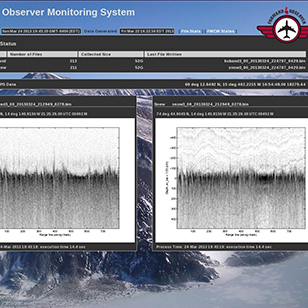STORAGE
IU innovations continue to help NASA manage big data
As the largest airborne survey of Earth's polar ice, the twice-yearly IceBridge missions generate massive amounts of data - all stored and archived by Indiana University's research cyberinfrastructure.
For the past four years, IU Research Technologies, a cyberinfrastructure and service center affiliated with the Pervasive Technology Institute (PTI), has provided IT support for the Center for Remote Sensing of Ice Sheets (CReSIS), a National Science Foundation Science and Technology Center led by the University of Kansas. Kansas scientists provide NASA with the radar technology that measures the physical interactions of polar ice sheets in Greenland, Chile and Antarctica.
IU experts bring innovative data management and storage solutions to the missions.

"Essentially, IU has built a supercomputer that can fly," said Rich Knepper, manager of IU's campus bridging and research infrastructure team within Research Technologies. "During this current mission, our system provided analysis of radar data as the data was collected - in real time -- allowing mission scientists to see the ice bed information as the plane flies over the Arctic."
The IU and CReSIS relationship grew from academic research led by IU Distinguished Professor Geoffrey C. Fox, who leads the IU Digital Science Center. The Digital Science Center is affiliated with the IU School of Informatics and PTI.
During last fall's trip to Antarctica, IU unveiled its in-flight data copy system, a tool that enables real-time data processing and archiving. With instant access to their data, the scientists can determine in flight which polar ice sheets require a closer look, saving time and money. (Read more about this tool: http://go.iu.edu/60w).
The in-flight data copy system is a proven success, having processed 21 Terabytes of data about the South Pole's ice sheets. This year's IceBridge Arctic campaign runs from March 18 to May 3, operating out of airfields in Thule and Kangerlussuaq, Greenland, and Fairbanks, Alaska. The IU tool is expected to collect close to 90 Terabytes of information. Matt Standish, IU systems administrator and core services team lead for Research Technologies, created the in-flight data copy system and accompanies it on the missions. (Read more about Standish: http://go.iu.edu/72D)
The success of these data storage and processing innovations depends on IU's Polar Research Operations Center (PROC), located within the Data Center at IU Bloomington. This state-of-the-art facility is designed to ensure the safety and security of IU's advanced networking, computer processing and data storage equipment. Thanks to PROC, the Research Technologies team has a dedicated space to experiment with new processes and breakthroughs designed to speed science.
"This facility allows us to prepare mission equipment, build storage sets and transfer data for processing - all in one space, both physically and electronically," said Matt Link, director of systems for IU Research Technologies. "It's the perfect place to prototype our systems and ensure they meet the high standards of performance we expect, and for which IU is known."
